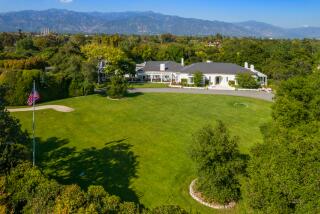A steal at $6.8 million? Al would laugh
- Share via
Recently, I paused to gaze upon the former West Coast residence of one Alphonse Capone. In a sign that I really did need a vacation, I found myself contemplating the place in real estate terms -- concluding that in property-mad San Francisco, only the protection of the National Park Service could constrain somebody from trying to take the building condo.
Capone’s digs are, in the parlance of only the most doggedly upbeat real estate agent, “compact.” He resided in 45 square feet of space on the second tier of Cell Block B in the former federal prison on the island of Alcatraz, which is now, incongruously, part of the Golden Gate National Recreation Area. Not only is his unit space-impaired, it doesn’t “show” well, as it is decked out with only a fold-down cot, mattress, Army blanket and sink.
Chicago’s favorite crime boss spent fewer than five years there, arriving in 1934 after the feds got him for tax evasion. Eventually he returned, a free but sick man, to the considerably more commodious home he had purchased in 1928 on Palm Island in Miami Beach.
Now that’s a piece of real estate. As I was brooding about the glorious view of San Francisco from Alcatraz Island, Miami real estate agent Barbara Hagen was listing the Palm Island house for sale for $6.8 million.
“That’s not a high price,” said Hagen, who explained that the walled, 30,000-square-foot lot also contains a pool, cabana and gatehouse. Hagen said a vacant lot nearby recently sold for $5 million, and a nearby home is listed for $13.9 million.
But, alas, Capone’s four-bedroom, Spanish-style home suffers from the greatest sin in real estate: It needs updating.
“Over the years, nobody has done a thing to it,” Hagen said. “It’s basically original, from 1928.” Among its features are the original light fixtures and some dandy Art Deco tile work. But there’s also a lot of cracking plaster, ‘70s vinyl tile, tired plumbing and worn hardwood flooring. And no air conditioning.
“Anybody who buys this property will want to restore it,” said Hagen, who added the place isn’t a tear-down. City approval would be required for any significant exterior alteration.
“The city would allow somebody to change the interior around,” she said. “They won’t allow demolition.”
And so it sits, in (decaying) bayfront magnificence, but probably not for long. Almost as soon as it went on the market, Hagen’s company’s website noted it as “pending,” meaning that a sales contract apparently was in the works. Hagen said she was forbidden to discuss contracts.
Capone, who died in 1947, spent his last days at the house, watched over by his associates as he suffered from syphilis-induced dementia.
As a man who undoubtedly knew the value of a buck, he’d probably hoot at the $6.8-million price tag, considering that he paid $40,000 for the place. And, as a man who was creative with his tax returns, capital gains might not have been much of an issue.
More to Read
Inside the business of entertainment
The Wide Shot brings you news, analysis and insights on everything from streaming wars to production — and what it all means for the future.
You may occasionally receive promotional content from the Los Angeles Times.










